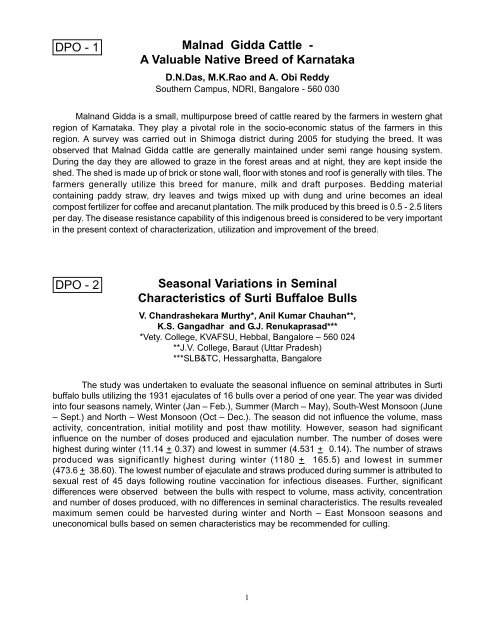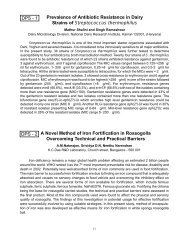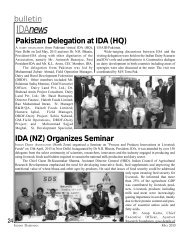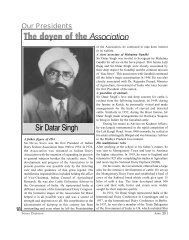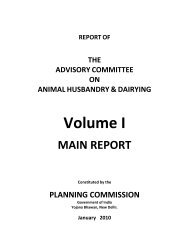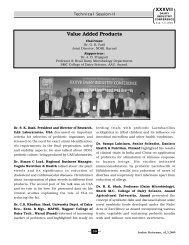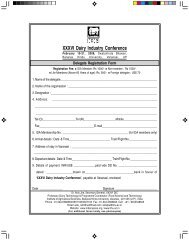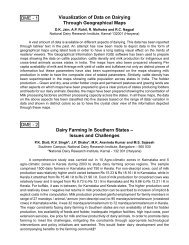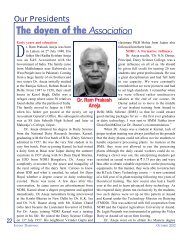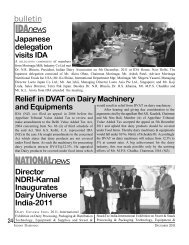Malnad Gidda Cattle - A Valuable Native Breed of Karnataka ...
Malnad Gidda Cattle - A Valuable Native Breed of Karnataka ...
Malnad Gidda Cattle - A Valuable Native Breed of Karnataka ...
- No tags were found...
You also want an ePaper? Increase the reach of your titles
YUMPU automatically turns print PDFs into web optimized ePapers that Google loves.
DPO - 5Criteria for Culling Surti Buffalo BullsV. Chandrashekara Murthy*, Anil Kumar Chauhan**,K.S. Gangadhar and G.J. Renukaprasad****Vety. College, KVAFSU, Hebbal, Bangalore – 560 024**J.V. College, Baraut (Uttar Pradesh)***SLB&TC, Hessarghatta, BangaloreThe data <strong>of</strong> culling 88 Surti Buffalo bulls over a period <strong>of</strong> 20 years maintained at the StateLivestock <strong>Breed</strong>ing and Training Centre, Hessarghatta was utilized in the present study to assess thevarious reasons for culling. The various reasons <strong>of</strong> culling were grouped into senility (G1),performance (G2), seminal quality (G3) and disease and deformities (G4). Among the differentreasons for culling, senility constituted 35%, followed by performance 30%, seminal quality (28%)and disease and deformities (7%). Although the senility was the main cause observed, it is pertinentto include the performance and seminal quality parameters and be given equal weightage whichculling the bulls. Further, senility established 55% in G1, poor libido 60% in G2 and poor freezability31% in G3 were the major causes for culling within each group in Surti buffalo bulls.DPO - 6Zinc Status in Feed and Fodder <strong>of</strong> Arid Zone, BioAvailability and Requirement For Milk ProductionG.P. SinghNational Research Centre on Camel, P. B. No, 07, Bikaner - 334 001 (Rajasthan)Zinc is one <strong>of</strong> most important trace minerals that plays very significant role in bio chemicalreactions. Zinc is required for effective digestion, absorption metabolic utilization <strong>of</strong> other nutrientsand is essential for conversion <strong>of</strong> â carotine to vitamin- A. Feed and fodders samples were collectedfrom randomly selected villages <strong>of</strong> Bikaner, Churu, Jaiselmer and Nagour districts <strong>of</strong> Rajasthan alongwith fodders available at National Research Centre on Camel, (NRCC) for feeding. Zinccontent in feed and fodders and their bio availability were determined. Requirement <strong>of</strong> zinc for milkproduction was calculated using equations developed. Average zinc content in feed and fodder <strong>of</strong>NRCC, Bikaner, Churu, Jaisalmer and Nagour districts were 30.82 (9.7-52.0); 30.81 (12.2-138.5);43.13(0.8-87.4); 20-64 (10.2-64.80) and 26.77 (7.8-164.0) mg/kg DM, respectively. Zinc content washighest in feed and fodder <strong>of</strong> Churu and lowest in Jaisalmer. However, 73.7,78.2,35.4,93.6 and 89.7per cent samples contained less than 40 mg/kg DM. The average bio availability <strong>of</strong> zinc from feedand fodders <strong>of</strong> arid zone was 59.76 per cent. The zinc requirement <strong>of</strong> 550 kg lactating camels with 4kg milk yield was 33.28 mg/day available zinc. Thus the feed and fodders <strong>of</strong> arid zone need zincsupplementation. Mineral mixture <strong>of</strong> arid zone <strong>of</strong> Rajasthan must contain extra zinc to meet thedeficiency <strong>of</strong> feed and fodders.3
DPO - 7Mineral Status <strong>of</strong> Goats Under IntensiveFeeding ConditionsS.B. Nageswara Rao*, Nawab Singh and T.K. DuttaCentral Institute for Research on Goats, Makhdoom - 281 122 (UP)*National Institute <strong>of</strong> Animal Nutrition and Physiology, Bangalore - 560 030For better performance <strong>of</strong> livestock, minerals are equally essential like protein, energy, waterand vitamins. Mineral status <strong>of</strong> farm animals under intensive feeding conditions will serve as base linevalues for comparing the values obtained under field conditions. In the present study, blood samples(n=46) and hair samples (n=23) <strong>of</strong> goats were collected under farm conditions. The goats in the farmwere receiving concentrate mixture, green fodder and pulse straw (arhar or gram) as per feedingschedule. Goats above six months age were allowed for grazing for six hours on natural pasturecomprising anjan (Cenchrus celiaris) grass. Blood samples were analyzed for copper, zinc, iron,calcium and magnesium. The hair samples were analyzed for copper, zinc, iron and manganese. Onthe whole, the concentration <strong>of</strong> blood minerals in kids is higher than the adults indicating morephysiological activity in kids as compared to adults (1.00 ± 0.04 and 0.07±0.05 ppm for copper 7.11±0.34and 4.87±0.21 ppm for iron, 2.78±0.15 and 2.18±0.14 for zinc: 18.26±0.46 and 17.15±0.76 mg /100ml for calcium and 8.21±0.61 and 7.48±0.71mg/100ml for magnesium). The concentration <strong>of</strong>minerals in hair samples was found to be 170.20±16.70 ppm for Zn, 6.69±0.55 ppm for copper,390.02 ± 29.43 ppm for iron and 53.08 ±1.45 for manganese. Hence, the mineral status valuesobtained under intensive feeding conditions will serve as base line values for field conditions.DPO - 8Assessing the Associative Effects <strong>of</strong> FeedIngredients in Compound FeedThirumalesh, T * ., Krishnamoorthy, U. and Kiran, D.Dept. LPM, KVAFSU, Veterinary College, Bangalore - 560 024Rumen fermentation characteristics <strong>of</strong> feed protein and carbohydrates influence efficiency <strong>of</strong>microbial protein synthesis. Stimulation <strong>of</strong> rumen fermentation by presence <strong>of</strong> some feed ingredientsmight alter the digestibility <strong>of</strong> other feed ingredients in a ration. Associative effects occur when digestion<strong>of</strong> one ingredient is not independent <strong>of</strong> other feeds and could be detected using in vitro gas productiontest. In this context, six mixed diets with finger millet straw as a roughage component (70% as is)across all the diets and 8 supplementary concentrate mixtures (CFM) were formulated to be similar inrumen degraded protein and energy content. Evaluation <strong>of</strong> these compounded feeds for gas productionrevealed significant associative effects at 8, 10 12, 24, 48 and 72 h <strong>of</strong> incubation which was 26.4,30.1, 25.1, 13.6, 5.32 and –4.45%, respectively for 6 mixed diets and resulted in significant (P
DPO - 9Trace Mineral Status in Feeds and FoddersK.S.N.Prasad and A. Obi ReddySouthern Campus, NDRI, Bangalore-30Urban dairy farmers largely depend on green grasses grown on sewage water irrigation. Thestudy was focussed on sewage and non-sewage dependant dairy farmers to analyse trace mineralstatus in and around Bangalore. A total <strong>of</strong> about 200 samples <strong>of</strong> wheat bran, groundnut cake,concentrate mixture, ragi straw, maize fodder, hybrid napier, para grass, guinea grass andmiscellaneous grasses were collected from these areas. The samples were analysed for copper,manganese, zinc and iron on Atomic absorption spectrometry. The results showed that Cu, Mn, Zn& Fe in concentrate feeds were in the range <strong>of</strong> 16-88, 33-114, 21-86 and 111-343 ppm, respectively,where as in roughages, the ranges were 17-68, 30-225, 40-97 and 178-621 ppm respectively. Thecopper, manganese and iron were found to be high values in almost all samples while Znwas deficient in most <strong>of</strong> the samples. The manganese and iron were high in roughages than inconcentrates in most <strong>of</strong> the areas irrespective <strong>of</strong> sewage water. The area specific mineral mixturesare suitable for this region, as some trace minerals are excess and others are in deficient in this studyarea.DPO - 10Feed Evaluation for Rumen MicrobialProtein SynthesisKiran, D. and Krishnamoorthy, U.Dept. <strong>of</strong> LPM, KVAFSU, Veterinary College, Bangalore - 560 024The study was conducted to establish rumen fermentation characteristics for the feedingredients commonly used in the manufacturing <strong>of</strong> compounded cattle feeds and/or in feeding largeruminants in Bangalore and surrounding districts <strong>of</strong> <strong>Karnataka</strong> state. The feed samples selected forthe study included 8 protein sources, 9 energy sources, 8 varieties <strong>of</strong> finger millet straw and12 varieties <strong>of</strong> rice straw. The fermentation characteristics were studied by measuring the gasproduction in vitro and by fitting the cumulative gas production against time <strong>of</strong> incubation in theexponential model. The D, and k for protein sources varied from 28.21 to 59.31 and 0.0858 to0.1562, for energy sources from 65.39 to 95.34 and 0.0544 to 0.1078, for finger millet straw from47.17 to 56.58 and 0.0493 to 0.0774 and for rice straw from 46.30 to 55.45 and 0.0260 to 0.0375,respectively. The feed samples were incubated again to determine the cumulative gas productionand substrate disappearance at time <strong>of</strong> half asymptotic gas production (t 1/2). The ratio <strong>of</strong> milligramsubstrate truly digested to milliliter gas produced at t 1/2(Partitioning Factor (PF)) was used as anindex <strong>of</strong> efficiency microbial protein synthesis. The PF, for the respective group <strong>of</strong> feedstuffs variedfrom 3.86 to 6.31, 3.28 to 4.53, 2.73 to 3.72 and 2.55 to 3.23.5
DPO - 11Evaluation <strong>of</strong> Mineral – Dependent Enzymes asBiochemical Markers forAssessing Mineral Status in AnimalsD.T. Pal, C.S. Prasad and N.K.S. GowdaNational Institute <strong>of</strong> Animal Nutrition and Physiology, Bangalore- 560 030The present study is aimed at assessing the effect <strong>of</strong> dietary levels <strong>of</strong> copper (Cu) and Zinc(Zn) on plasma mineral concentrations and Cu and Zn-dependent enzyme activities in sheep.Eighteen sheep were assigned into three dietary treatments <strong>of</strong> six animal each in a completelyrandomized design and fed a basal diet (maize-soyabean meal-urea) alone (control; group–I ) andsame diet supplemented with 650% (group o II) or 100% (group-III) more Cu and Zn over basal levels(control) through CuSO 4and ZnSO 4sources for a period <strong>of</strong> 120 days. Blood samples were collectedat monthly interval for estimation <strong>of</strong> plasma mineral concentrations and copper and zinc-dependentenzymes activities. Plasma Cu and Zn concentrations were significantly (P
DPO -13“Ovsynch: A Novel Estrous SynchronizationProtocol For Augmentation <strong>of</strong> Reproduction inRepeat <strong>Breed</strong>ing Buffalo Heifers.”K.S. Roy * & B.S. Prakash *** National Institute <strong>of</strong> Animal Nutrition & Physiology, Bangalore - 560030**Dept. <strong>of</strong> Dairy <strong>Cattle</strong> Physiology, NDRI, Karnal – 132001 (Haryana)The present research was undertaken to investigate the efficacy <strong>of</strong> Ovsynch protocol for estrussynchronization with or without anti-prolactin (Norprolac) treatment in repeat breeding Murrah buffaloheifers following TAI (Timed artificial insemination) during summer months, through intensiveendocrine analysis. For the first time a sensitive enzyme immunoassay (EIA) was standardized andbiologically validated for prolactin estimation in buffalo blood plasma. The Norprolac dose wasstandardized and a dose <strong>of</strong> 10.0 mg / animal was found to be suitable for prolactin suppression upto30 hours. The hormones quantified in blood plasma samples collected before, during and after Ovsynchand Ovsynch plus Norprolac treatment were LH, prolactin, progesterone, estradiol –17b and totalestrogens. All the animals subjected to Ovsynch treatment (with or without Norprolac) wereinseminated at fixed time at 12 h and 24 h post second GnRH injection. Mean plasma prolactinconcentrations during cyclicity in buffalo heifers were 40 to 70 times higher in summer months (248.50± 16.03 to 369.63 ± 25.13 ng/ml). Plasma prolactin and progesterone concentrations were negativelycorrelated (r = - 0.24) during estrous cycle. In Ovsynch (without prolactin inhibition) treatment 45% <strong>of</strong>animal and in Ovsynch plus Norprolac treatment, 55% <strong>of</strong> animal became pregnant duringsubsequent insemination. It is concluded that Ovsynch protocol for estrus synchronization couldhave potential application for improvement <strong>of</strong> fertility in repeat breeding buffaloes even duringextreme summer months in combination with suppression <strong>of</strong> prolactin secretion.DPO -14Exon 8 Polymorphism <strong>of</strong> DGAT 1 Gene in BovinesSrinivasa Raghavan, V; S.L.Goswami, S.De, T.K.Datta,Manish Kumar, Riti Singh, and Satyapal YadavAnimal Biotechnology Center, NDRI, Karnal – 132 001 (Haryana)The study attempted to identify polymorphism in exon 8 <strong>of</strong> DGAT 1 gene in indigenous cattle(Sahiwal), crossbred cattle (Karan Fries) and Murrah breed <strong>of</strong> buffalo. The genomic DNA wasextracted from blood samples collected from 50 adult lactating animals <strong>of</strong> each breed using high saltmethod. The polymerase chain reaction was conducted to amplify a 381 bp size product usingappropriately designed primers and was confirmed on agarose gel. The amplified product wassubjected to single strand confirmation polymorphism (SSCP) analysis on a poly-acrylamide gel. Allthe animals <strong>of</strong> Sahiwal breed were found to be monomorphic. In case <strong>of</strong> Karan Fries and Murrahbreed, 3 different SSCP patterns were observed. Thus based on gel band pattern, the respectivePCR products were sequenced to identify single base changes. Sahiwal and Murrah breeds werefound to be monomorphic (AA) at positions 10433 and 10434 <strong>of</strong> exon 8, where as taurine breedscontain GC at the same position. In case <strong>of</strong> Karan Fries, two types <strong>of</strong> sequence variations were foundand 56% <strong>of</strong> animals were <strong>of</strong> heterozygous type (GC / AA) and 44 % <strong>of</strong> animals were <strong>of</strong> homozygoustype (14 % animals with AA / AA and 30% <strong>of</strong> animals with GC / GC). The polymorphism in exon 8causes a change in amino acid make up at position 232 <strong>of</strong> mature protein from lysine (AA) to alanine(GC). Even though exon 8 <strong>of</strong> Karan Fries showed two sequence variations, still they were statisticallynon-significant with respect to 305 days fat yield and average monthly fat yield warranting study inlarge population.7
DPO -15Goat Milk – A Future Health FoodP.K.Rout, Ajay Kumar, R. RoyCentral Institute for Research on Goats, Makhdoom – 281 122 (UP)Goat milk has significance in human nutrition. The present study was initiated in Indian goats tocharacterize them both at protein and genomic level and to study the milk proteomics for furthercommercial application. The as 1-casein A allele was observed in the majority <strong>of</strong> goats and theirfrequency in Jamunapari, Barbari, Marwari, Sirohi, Jakhrana, Beetal and non-descript goat from U.Pand M.P was 0.71, 0.77, 0.56, 0.76, 0.67, 0.72, 0.45, 0.58 and 0.52, respectively. In as 1-casein locus,the A variant had highest frequency in all the breeds, however Marwari, Ganjam and non-descriptgoats from U.P and M.P had moderate gene frequency <strong>of</strong> 0.564, 0.450, 0.586 and 0.525,respectively. Barbari had highest and Ganjam goats had lowest as 1-Cn A gene frequency. DNA samples<strong>of</strong> Indian goats were analyzed for the presence <strong>of</strong> different as 1-casein allele. AA genotype hadhighest frequency in Indian goats. The molecular analysis at DNA level revealed mainly A, B, C, D, Eand F allele at CSN1S1 locus. The analysis indicated that the Indian goat breeds are carrying A allelein higher frequency except Ganjam and local goats indicating the availability <strong>of</strong> high amount <strong>of</strong>protein in milk <strong>of</strong> Indian goats.DPO -16Effect <strong>of</strong> Individual or Group Culture onDevelopment <strong>of</strong> Buffalo Preantral FolliclesH.S. Ramesh*, P.S.P. Gupta**, J.P. Ravindra** and V. Chandrashekar Murthy** KVAFSU, Veterinary College, Bangalore – 560 024**National Institute <strong>of</strong> Animal Nutrition and Physiology, Bangalore – 560 030Buffaloes are important dairy animals in India. However one <strong>of</strong> the constraints in exploiting thefull potential is their inherent reproductive problems. Assisted reproductive technologies can be adoptedto overcome the problems. Efforts are being made to utilize preantral follicles in the ovaries forembryo resource generation. Present study attempted to investigate the effect <strong>of</strong> individual and groupculture on in vitro development <strong>of</strong> large preantral follicles in buffaloes. Large preantral follicles <strong>of</strong>150 to 500 mm size isolated by micro-dissection method from slaughter house derived ovaries wereplaced individually or in groups in minimum essential medium (MEM) with supplements and culturedin a CO 2incubator for 80 days. There was no significant difference (P>0.05) in the size <strong>of</strong> folliclesbetween the two groups. However, the preantral follicles in-group culture showed a significantly higher(P
DPO -17Effect <strong>of</strong> Feeding Two Levels <strong>of</strong> Energy andBypass Protein on Production Performance<strong>of</strong> Lactating Crossbred GoatsMieso Guru and Shiv PrasadDairy <strong>Cattle</strong> <strong>Breed</strong>ing Division, NDRI, Karnal – 132 001 (Haryana)An experiment was conducted on 20 lactating crossbred does in early lactation duringJanuary – March 2002. The treatments consisted <strong>of</strong> (i) medium concentrate (@3% <strong>of</strong> BW) with lowby pass protein (RDP:UDP; 69:31) (T 1), (ii) high concentrate (@4% <strong>of</strong> body weight) with low bypassprotein (T 2), (iii) medium concentrate (3% <strong>of</strong> BW) with high by pass protein (RDP : UDP; 52:48) (T 3)and high concentrate (4% <strong>of</strong> BW) with high bypass protein (T 4). The overall means for 4% FCM yieldin the treatment groups T 1, T 2, T 3and T 4were; 1.18 + 0.03, 1.60+ 0.03, 1.75 + 0.03 and 1.95 + 0.04kg per doe per day respectively. The overall FCM yield / kg W 0.7 averaged 0.10+ 0.001, 0.13+ 0.02,0.014 + 0.02 and 0.16 + 0.003 kg respectively in the respective treatment groups. Milk yield/doe/d,4% FCM yield/doe/d as well as FCM yield/kgW 0.07 all were highest in treatment group T 4the treatmenteffect was significant (P
DPO -19Effect <strong>of</strong> Body Condition on ReproductivePerformance in Crossbred Dairy <strong>Cattle</strong>K. Ningaraju*, M.M. Kailas**, K. Narayana**, A. Krishnaswamy**,R. Bhaskaran** and B.N. Suresh*** Southern Campus, National Dairy Research Institute, Bangalore – 560 030**Veterinary College, KVAFSU, Hebbal, Bangalore – 560 024The relationship <strong>of</strong> body condition score (BCS) at calving and changes in body weight duringeight weeks postpartum and reproductive events was evaluated by milk progesterone concentrationin 36 cows. The number <strong>of</strong> cows in group G1 (BCS <strong>of</strong> 2.55+ 0.06), G2 (BCS <strong>of</strong> 3.13+ 0.05) and G3(BCS <strong>of</strong> 3.65+0.065) was 11, 12 and 13 respectively. The body weight change differed at eight weeks<strong>of</strong> postpartum among cows in G1 and G3 suggesting that cows having low body condition at calvingtend to lose more body weight. The milk progesterone assay indicated luteal activity at 11 days in fourcows. 9 days in seven cows in G1, 13 days in six cows and 9 days in six cows in G2 and 14 days infour cows and 9 days in nine cows in G3. Four, three and three cows in G1, G2 and G3 exhibitednormal luteal phase <strong>of</strong> 12 to 17 days. Seven, five and ten cows in G1, G2 and G3 exhibited shortluteal phase <strong>of</strong> 6 to 11 days during the first ovarian cycle. Two, three and three cows in G1, G2 andG3 exhibited shortened luteal phase. Six, five and seven cows and short luteal phase and two, fourand three were anoestrus in cows <strong>of</strong> G1, G2 and G3, respectively. The present study revealed thatcows with low BCS and high BCS are vulnerable for postpartum ovarian disturbances. The delay inthe initiation <strong>of</strong> normal postpartum cyclicity is associated with body weight and BCS in cows at calving.This can be modified by optimizing the energy deficiency with better feeding management in earlypostpartum period.


